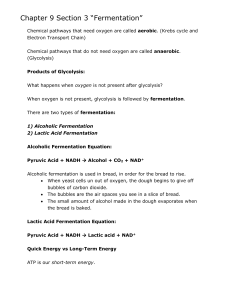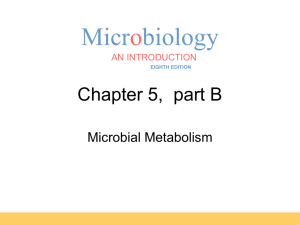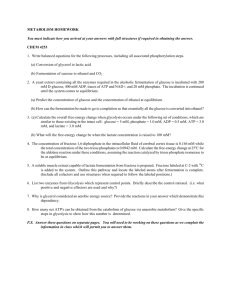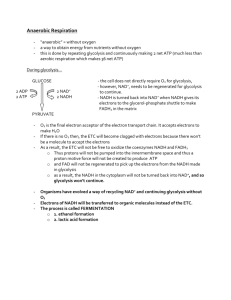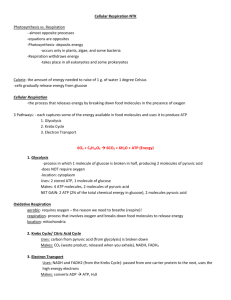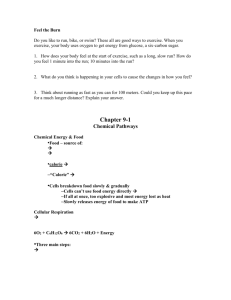Anaerobic Respiration
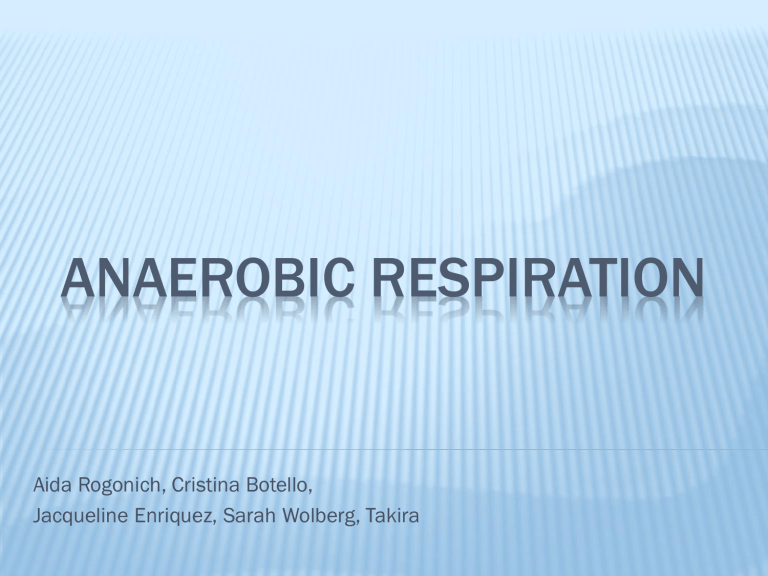
ANAEROBIC RESPIRATION
Aida Rogonich, Cristina Botello,
Jacqueline Enriquez, Sarah Wolberg, Takira
ALCOHOL FERMENTATION: STEP ONE
Glycolysis is the breaking of a carbohydrate into two pyruvates
Occurs in the cytoplasm of cells
No oxygen needed.
GLYCOLYSIS: PART ONE
2 PGAL’s (Phosphoglyceraldehyde - 3Carbon molecules) are formed from the breaking down of glucose (6C)
Two ATP's are required
GLYCOLYSIS: PART TWO
2 pyruvates are created from 2 PGAL's (3C)
Producing 4 ATP's and 2 NADH's
Net production = 2ATP’s and 3 NADH’s
WHERE DOES IT OCCUR?
No oxygen is used
2 Acetaldehyde is reduced by NADH to ethanol
Regenerating supply of
NAD+
Carbon dioxide may be realeased
Glycolysis continues
2
ND
STEP
IN THE CYTOSOL OF YEAST!
2
ND
STEP CONT.
When the first step occurs and 2 acetaldehyde is formed, 2 CO ₂ is released
Then acetaldehyde accepts hydrogen and electrons from the 2 NADH formed through
Glycolysis
With the combining of e-, H+, and 2 acetaldehyde, 2 NAD+ is regenerated and
2ethanol is created
ALCOHOLIC FERMENTATION: LACTIC ACID FERMENTATION:
Glucose + 2 ADP + 2 Pі
2 ethanol + 2 CO ₂ + 2 ATP
+ 2 H ₂ O
OR
C ₆ H ₁₂ O ₆ 2 C ₂ H ₅ OH + 2
CO
2
Glucose + 2 ADP + 2 Pi
2 lactate + ATP + 2
H ₂ O
ALCOHOLIC FERMENTATION EQUATION
SUMMARIZATION OF FERMENTATION
HTTP://TRC.UCDAVIS.EDU/BIOSCI10V/BIS10V/MEDIA/CH06/FERMENTATION.SWF
WHAT ORGANISMS
USE LACTIC ACID FERMENTATION?
Fermented vegetables
Pickles!
The sugars in the pickles are converted to lactic acid, preserving the pickle
Lactobacillus bulgaricus – a bacteria
Yogurt
Lactose is fermented by the bacteria to lactic acid, which both thickens the yogurt and restricts the growth of bacteria that poisons the food
Humans
during anaerobic exercise
lactic acid is fermented in muscles where oxygen is depleted
makes muscles burn
RESOURCES
http://www.icr.org/article/172/
http://trc.ucdavis.edu/biosci10v/bis10v/medi a/ch06/fermentation.swf
http://www.bio.miami.edu/~cmallery/255/255 atp/mcb8.5.fermentation.jpg

